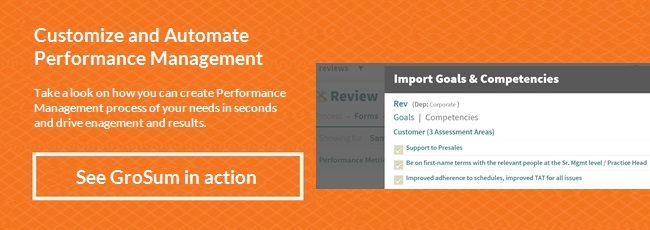
Annual Performance Review is DEAD!
Finally, year-end would mean new opportunities, career counseling, and new possibilities. It is so heartening to see the way the change is getting welcomed by employees and management alike. No more rivalry and negative competition, high levels of attrition and low level of trust amongst employees.
Annual appraisals always made me wonder- What is that motivates us to work? Do we like our job or is it just the paycheck we care about? Are we motivated enough? Will we do anything apart from what our jobs demand us to?
The answer never changed. Many decades of the same practice, years of paperwork and so many man hours wasted every year. More than 10% of the Fortune 500 companies have declared the Annual Performance Review dead. Thanks to the new development, employees of many companies can now have a big sigh of relief. This year will be different. Company’s attitude towards annual performance reviews have changed and they have understood the value of continuous feedback. This year the employees can expect a changed atmosphere, a different approach to a never-ending discussion- How to appraise employee and are we doing it right?
Were Annual Reviews any good?
This is the question which is in every employee’s mind. Every year, companies go through a grueling and time-consuming task of reviewing their employees. But a year is too long a time to review your own goals let alone your team or your subordinates. Every year, employees wait anxiously for the long waited increments or promotion and every year there seemed something pulling them down. The employee blamed his superior, his superior blamed the HR and them, in turn, blamed the management for the review results. There was no transparency in the process and the employees always ended up feeling demotivated or undervalued. The traditional appraisal was the most ineffective and the most hated. But management didn’t have any other mode of evaluating performance. As one colleague of mine said, there was just no scope of learning or improvement. Low performance would always have a serious consequence no matter what the circumstances were for that.
According to a survey of 2500 organizations across 90 counties by a consultancy firm Bersin by Deloitte, only 8% of the companies were in favor of their appraisal system, around 58% felt that it was a complete waste of time. Around one-third of the employees feel that the appraisal system is not fair and around one in five employees feel that there is a lack of communication when it comes to goal setting and performance expectations. Almost always, companies have gone for a performance appraisal system which has some kind of ranking system and has a reward system. But when it came to employee feedback and constant evaluation and counseling, all of them had a back seat.
Employee Vs Management- Who lost more in Performance Management?
Performance appraisal system was based on the belief that employees must be ranked based on their contribution to the organization and must be rewarded accordingly. But this has many limitations. While ranking might be an easier way to reward, it is very difficult to analyze how much behind is the employee next in line. In this method, the conditions leading to poor performance are also not considered. There is an instance where low productivity might also be due to the lack of projects in a team. This creates distrust among the employees. The fact that the management has to finally rank or rate the employees leaves them with no alternative but to review some employees in the below average stratum.
An average or below average rating end of the year leaves the employee shocked and disheartened. There was just no way of knowing what went wrong and how to correct it till the reviews come out and then there is no scope of correction. The superior who found my work ok till yesterday suddenly review it at the year end and says my performance is not up to the mark. Not something anyone would take lightly. If this was the situation of the employees, the management was no better. Every year around 12-15% of the total employee strength leaves due to the performance review. Attrition means additional training cost for the new hires and less productivity during the training period. According to a report by the Association of Talent Development, the lesser the employee base, the more is the training cost. For a small company (less than 500 employees) the average training costs are around $1,888 and for a mid-sized company, it comes down to $838 per employee. The cost difference is however compensated by the number of man-hours of training. So when a company loses an employee, it not only loses a trained asset but also incurs further training cost and man-hours. The employees who still remained were in constant fear of bad review and had low motivation level. To add to it was the atmosphere of negativity and rivalry. So, neither the company grew nor the employees. This had to change.
Drop the “Annual” from the Appraisal Process
The main aim of an appraisal process should be to better evaluate an employee and train him to perform better not to rank them. A good appraisal process has scope for feedbacks and re-evaluation. That can happen only when there is a continuous performance review with feedback on a regular basis. Regular feedback without the fear of ranking leads to positive reception. It also leads to trust and unity among team members and supervisors. Also, a more free and open channel of communication can be established leading to a positive work environment and satisfied employees. Laszlo Bock, SVP of People Operations at Google, recently wrote, “Performance management as practiced by most organizations has become a rule-based, bureaucratic process, existing as an end in itself rather than actually shaping performance.” Managers must be trained to act like a coach by setting up short-term goals and do a continuous performance evaluation on a regular basis. Setting short-term goals enable the managers to evaluate better and give detailed and productive feedback. It also enables scope for training and development as and when the need arises.
According to Lazlo Block’s recent book, “Work Rules: Insights from inside Google”, an employee leaves a manager, not the company. So it is very important that the manager is evaluated properly and that’s what Google does. It provides a set of question for the team members to evaluate their manager. This is called the Upward Feedback Survey. The question doesn’t just focus on the manager’s technical expertise and his ability to manage and keep the team focused but also in his capability to communicate and sharing information, goal setting and giving positive and clear feedback.
It was observed, that millennials (1982-2000 born) form the largest part of the workforce. They have a new outlook on work, are strong in technological skills, come with an ability to multitask and often prefer working in teams. They have a different attitude towards feedbacks and reviews as well. These employees expect frequent or immediate feedbacks and expect speedy growth. These are the people who believe in creative thinking and out of the box solution to complex problems. Retaining them is not only necessary but also requires a different method altogether. Managers must ensure that they have an altered strategy to accommodate the needs of the organization.
For an effective employee performance evaluation, it is very important that the management takes into account a combination of peer review and skill and performance mapping. A 360-degree performance review is very effective when done in the right way. A face to face discussion with the employees on their self-developmental goals and their interests would help the managers in understanding what the employees expect from the job. Also, understanding the employee from his co-workers, his superiors, clients, and stakeholders would improve the chance of evaluating him better.
The main reason why the annual appraisal system is dead is that it is “Annual” + “Appraisal”. One can never do justice to either of it when done together. Most of the employees have a tendency to alter their performance trend during the last quarter just so that they get reviewed better. Managers also cannot keep a track of a whole year of developments and just collate data at the last minute, usually of the last quarter. So, the end result is not as accurate as it should be. Setting short-term goals and having a discussion every quarter on the developments and progress ensures a strong relationship between the manager and his team. Also, it gives a scope of improvement to the employees thus increasing their trust in the system and overall job involvement. There is a continuous learning process ensuring that employees don’t feel monotony and boredom in their work schedule which affects their productivity.
Is there a better way out?
There are a few other ways which can replace the current ineffective and inaccurate method of employee evaluation and review. One of the popular processes which have been tested with positive reviews is the competency mapping procedure adopted by many companies in recent times. Here a particular project is analyzed to identify key competencies and skills required of it. Then, a benchmark is set on the expected level of competency and skill normally rated on a scale of 5 (1 being the least and 5 the best). Each of the team members in the project is evaluated on his actual level and the gap is determined by the benchmarked level and the actual level. This gap is then analyzed through a 360-degree approach to determine if it is normal to have that gap and if not what can the action plan be. Employees with a larger gap can be identified and evaluated for other competencies and can have a job rotation if found the fit elsewhere. The other employees with a lesser gap can be nominated for specific training sessions and closely evaluated at fixed intervals.
This mapping procedure is not only effective but can also be a projection for other analysis like training requirements, job rotations, promotions, and increments. It has been tried and successfully implemented in many organizations.
Conclusion
For any process to be effective, a proper approach and the right mindset is very essential. It is not enough that a particular process is changed. What matters more is the mindset to change. Managers must be trained to have the right attitude for evaluation. It must be noted that for effective employee evaluation, care must be taken to analyze the performance from the start taking into account all the possible reasons and outcomes. Before evaluating, a thorough study must be done on the employee performance sheet to make sure there is no miss or biasing. Finally, Appraisal time is not for evaluation. The evaluation must be done at regular short intervals to increase productivity and improve employee morale. As people say “A stitch in time, saves nine”.
What do you think?




[…] many organizations, performance reviews are still done only once a year. Growing number of managers and employees feel that the […]
[…] GE’s “[email protected]” is a new tool implemented by the company (which loves abbreviations) to replace the dreaded annual appraisal process, mainly courtesy the big chunk of Millennial they have in their workforce (Read this article on Annual Reviews are dead.) […]
[…] method is becoming outdated since automated feedback tools are preferred over traditional […]
[…] year-end evaluation to add salt to the […]
[…] away from a view of performance review or appraisal as something done sporadically, in fixed mediums, and in a one-size-fits-all format. […]
thanks for the information
good one keep it up
thanks for sharing this tips
This could be a vital decision if any alternative method of reviewing performance is not implemented. Some of the mentioned points are true though
[…] was predominantly one-sided, formed the basis of most employee evaluation processes. The classic ‘annual review’ tied closely with compensation was considered the be-all and end-all of this. This worked for a […]
[…] Annual reviews are par for the course in most organizations. […]